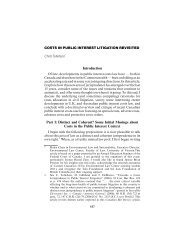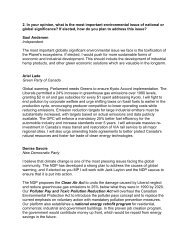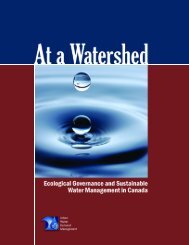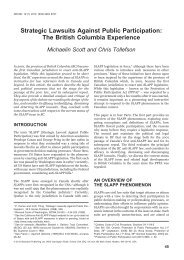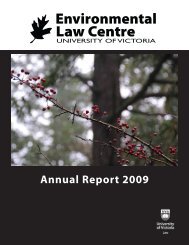Peeling back the Pavement - POLIS Water Sustainability Project
Peeling back the Pavement - POLIS Water Sustainability Project
Peeling back the Pavement - POLIS Water Sustainability Project
You also want an ePaper? Increase the reach of your titles
YUMPU automatically turns print PDFs into web optimized ePapers that Google loves.
BOX 4: VALUING PROPERLY FUNCTIONING ECOSYSTEMS<br />
“Stormwater” is strictly a human concept. Precipitation, on <strong>the</strong> o<strong>the</strong>r hand, is a dynamic<br />
process of <strong>the</strong> natural world. The hydrological cycle connects <strong>the</strong> atmosphere, surface<br />
water, soils, vegetation, and animals (including humans). The movement of water creates<br />
a dynamic equilibrium as it flows from rain, to water stored on <strong>the</strong> leaves of plants and in<br />
<strong>the</strong> soil, and <strong>the</strong>n <strong>back</strong> to <strong>the</strong> atmosphere through evapotranspiration. The flow of water<br />
through soil to groundwater and into streams and wetlands creates a baseflow for a watershed,<br />
which provides moisture to plants and animals during dry periods.<br />
Left to its own devices, <strong>the</strong> natural world is in a relatively comfortable state of equilibrium,<br />
maintained by constant change, rebalancing, growth, and decay. The natural<br />
water cycle in proper functioning condition supports ecologically productive wetlands,<br />
streams, and lakes. These bodies of water provide us with a critically important water<br />
supply as well as rich recreation, fish and wildlife, and cultural and historic values. They<br />
also provide key economic inputs necessary for everything from crop and livestock<br />
production to timber and energy production.<br />
But, many contemporary patterns of human settlement, such as rapid increase of<br />
impervious surfaces, fundamentally change <strong>the</strong>se relationships. In urbanized areas,<br />
streams and rivers frequently serve as conduits for pollution via urban stormwater<br />
runoff. Large water infrastructure projects also strain <strong>the</strong> resilience of complex natural<br />
systems by quickly moving large volumes of water within and even across watersheds.<br />
These impacts compromise <strong>the</strong> quality of <strong>the</strong> ecological, social, and economic services<br />
that watersheds provide.<br />
In <strong>the</strong> future, we will need to better integrate <strong>the</strong> environment into urban areas and<br />
mimic nature’s processes. As urban ecosystems, Canada’s cities must grow and decisions<br />
must be made in ways that protect and promote — not erode — <strong>the</strong> proper<br />
functioning condition of ecosystems. To do this, society needs to be prepared to make<br />
difficult trade-offs. As a starting point, we need to learn how to better value ecosystems<br />
and incorporate “full cost accounting” into all of our activities. We also need to plan on<br />
a much broader watershed scale and work with <strong>the</strong> water cycle, not against it.<br />
Sources on page 65.<br />
Photo: R.J. Frith<br />
23



